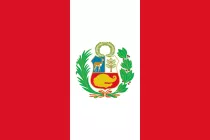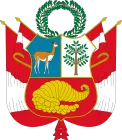Peru

Geographical Location of Peru
Peru is a republic in South America. Peru borders Ecuador and Colombia to the north, Brazil and Bolivia to the east, and Chile to the south. The Andes Mountains divide Peru into three distinct regions. The dry coastal areas on the western side of the mountain range are narrow plains with little rainfall and little variation between seasons. The highlands are humid, with regular showers and cooler weather than the rest of the country. On the eastern side of the Andes, the climate is tropical, with high temperatures and high rainfall during the rainy season.
In recent decades, Peru's climate has been affected by El Niño. The weather event causes warm ocean currents from the Pacific to change direction and flow along the equator towards the coast of South America. Water is pushing the cold Humboldt Current away from Peru, causing drought and problems for the fishing industry. The country is rich in resources, and rapid industrial development in the post-war period has made air and water pollution a major environmental problem. Another issue is landscape damage and environmentally harmful emissions associated with mining. Deforestation is an ongoing problem. Earthquakes occur at regular intervals.
Brief History of Peru
The oldest traces of settlement in Peru are at least 12,000 years old. In the 12th century, the Inca Empire arose in the area around the city of Cusco, which is located in the southern part of modern Peru. The empire grew and the conquests began in the 15th century, leading to the creation of the Inca Empire, covering a third of South America. In 1532, the Spanish conquest of the Inca Empire began. In the following centuries, mines and plantations were built where local people worked as slaves. For the indigenous population, Spanish colonial rule was a disaster. The combination of war, new diseases and forced labor led to numerous deaths.
The Peruvian War of Independence against the colonial government resulted in the country being the last in South America to become independent in 1821. The last Spanish troops were defeated in 1824. The new state was characterized by conflicts between various rebel groups and wars against the neighboring countries of Ecuador and Chile. Throughout the 20th century, power alternated between military dictatorships and democratically elected leaders. In 1980, the last military regime fell. The 1980s and 1990s were characterized by growing drug trafficking, economic crises and social discontent. Radical left-wing guerrilla groups emerged and more than 69,000 people died in brutal conflict with the army.
Society and Politics of Peru
Peru is a republic where the president is the head of state, military and government. The President is elected for a term of five years, but cannot be elected twice in a row. The President appoints the government. Congress is the legislative assembly and is elected concurrently for the same term.
Since the beginning of the new millennium, politics has been characterized by corruption scandals and large demonstrations. Indigenous people make up a significant portion of those protesting against the exploitation of natural resources and against industries that destroy the environment. Other important policy issues concern rising crime and drug trafficking. Police and security forces are also regularly accused of arbitrary detention, torture and other abuses. There are still large economic differences between different parts of the country and between social classes. Hispanics and European descendants constitute the elite, while the black minority suffers the most discrimination. Indigenous people and to some extent Asians also have a lower status in society.
Economy and Trade of Peru
In the post-war period, fluctuations were observed in the country's economy. After booming mining and fishing industries in the 1960s, an economic crisis struck in the 1980s. Market prices for the country's export goods have fallen sharply. After extensive economic reforms in the early 1990s, high inflation decreased. The country experienced significant economic growth between 2009 and 2013, driven by mining and exports of raw materials. Due to falling prices for these resources on the global market, economic growth slowed between 2014 and 2017. Moreover, much of Peru's economic growth over the past decade has been undermined by the corona pandemic.
Much of the population lives in poverty, especially in rural areas and urban slums. Peru has problems with a large underground economy. It is particularly associated with drugs, and the country is a major producer of cocaine.
The largest export commodities are minerals such as silver, copper, zinc, petroleum and gold, and other commodities such as fishmeal, cotton, sugar and coffee. In addition, the tourism industry is important because of the rich cultural heritage of Machu Pichu and the magnificent nature of the Andes and Amazon.
Peru has economic policies that promote free trade. The most important trading partner is China, followed by the EU and the US.







